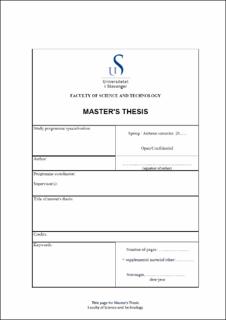| dc.contributor.author | Perez Garcia, Raul Oswaldo | |
| dc.date.accessioned | 2022-12-28T12:51:37Z | |
| dc.date.available | 2022-12-28T12:51:37Z | |
| dc.date.issued | 2017-06-29 | |
| dc.identifier.uri | https://hdl.handle.net/11250/3039661 | |
| dc.description | Master's thesis in Organic Chemistry | en_US |
| dc.description.abstract | Two main objectives drove the present effort. First and foremost, reactions of strained gem-dibromocyclopropanes with MeLi were to be investigated as a continuation of research done by Lars Skattebøl. Secondly, the overcoming of challenges regarding synthesis of α-hydroxyketones was pursued.
Strained gem-dibromocyclopropanes were prepared by building a dioxin ring upon seven- and eight-membered acyloins to arrive at bicyclic vinyl ethers and subsequently adding dibromocarbene. Oxathia- analogues of these vinyl ethers were also synthetized and cyclopropanated. Several pathways for their preparation were explored. Attempts at improving upon the method developed in Bakstad’s research group were not particularly successful and gave few good results that were difficult to reproduce. Experiments in the synthesis of benzyl-protected acyloins gave complex mixtures of products and instead hinted at α-ketol or Favorskii rearrangements, while synthesis of acetyl-protected acyloins only worked for acetophenone relatives.
A simple, versatile method previously undescribed involving epoxidation of enol acetates was developed that worked for the synthesis of acyloins and dihydrodioxins in two steps. The method sparked interest in the cyclopropanations and ring-openings of such enol acetates, which were briefly explored. The corresponding dibromocyclopropanes could not be isolated for ring-openings. In addition, a novel procedure for the preparation of 1,2-diketones was discovered as a result of the novel acyloin/dihydrodioxin synthesis.
Dibromocarbene was readily added to dihydrodioxins and dihydrooxathiins to afford strainedpropellanes. gem-Dibromopropellanes 8a and 8b reacted with MeLi to give the corresponding monobromides, 9a and 9b. Formations of 9a, 9b, and 10a were confirmed by additional isotope labelling experiments with heavy water. Reactions with benzyl bromide did not afford the expected coupling product but instead the reduced one, 9a, as when quenched with water.
Carbene trapping experiments with ethylvinyl ether were unsuccessful as the dibromides were left unreacted. Carbene insertion experiments with THF did not afford the expected insertion product 13a -instead, the dibromides reacted with MeLi and proceeded to dimerize to yield 14a. Additional analytical results of the MeLi reaction products are currently pending. | en_US |
| dc.language.iso | eng | en_US |
| dc.publisher | University of Stavanger, Norway | en_US |
| dc.relation.ispartofseries | Masteroppgave/UIS-TN-IMN/2017; | |
| dc.subject | kjemi | en_US |
| dc.subject | biokjemi | en_US |
| dc.title | Preparation and Reactions of Straind gem-Dibromocyclopropanes | en_US |
| dc.type | Master thesis | en_US |
| dc.subject.nsi | VDP::Matematikk og Naturvitenskap: 400::Kjemi: 440 | en_US |
